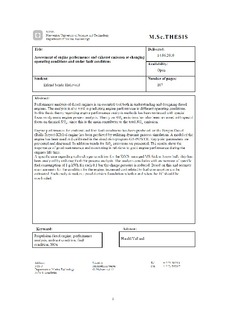| dc.contributor.author | Hatlevold, Erlend Sandø | nb_NO |
| dc.date.accessioned | 2014-12-19T12:05:39Z | |
| dc.date.available | 2014-12-19T12:05:39Z | |
| dc.date.created | 2010-11-25 | nb_NO |
| dc.date.issued | 2010 | nb_NO |
| dc.identifier | 372491 | nb_NO |
| dc.identifier.uri | http://hdl.handle.net/11250/237746 | |
| dc.description.abstract | Optimal engine performance during an engines operation lifetime is important to gain minimal costs related to fuel and maintenance cost. Downtime related to propulsion engine will also benefit from this. In this report operating conditions including ambient conditions, added loads and fault conditions for a ships propulsion engine has been identified and discussed. The main focus is on ambient conditions and fault conditions. The fault condition analysis is limited to four different conditions. Different performance models with different complexity are discussed regarding complexity, required inputs and accuracy. Dynamic process analyses are the most complex methods to use but will provide the most accurate results.
Exhaust emission theory with focus on NOx emissions has been elaborated. It is obvious that NOx production formed under high temperature and pressure, commonly known as thermal NOx, is the domination contributor to the total NOx emission from a diesel engine.
Performance analysis can involve all from single components to the entire engine. An engine model should be kept as "small" as possible but still be able to provide the desired results, this because a detailed model incorporating all engine components will require much time and processor power to calculate.
Simulations for ambient and fault conditions has been performed by utilising the computer program GT-POWER. This program is based on dynamic process analysis. A Bergen Diesel KRG-6 engine has been modelled in GT-power by the manufacturer and further calibrated during this thesis. The accuracy is within 2%. After calibration and initial simulation for standard condition, different ambient conditions has been introduced and simulated.
Ambient conditions effect on the engine performance can be estimated by utilising calculation routines based on ISO 3046. A comparison has been made between simulations in GT-POWER and ISO corrected performance. The result deviates but shows the same trends in performance.
Four fault conditions has been introduced to the GT-POWER model and simulated with different degree of fault condition. The results show the impact of the fault condition including altered NOx emission.
The fault conditions simulated will result in considerable increase of fuel consumption. This shows that proper monitoring and maintenance is beneficial. Engines operating with significant faults may not be able to produce the stated power because of parameters such as temperature and pressures are exceeding allowed limits.
A specific case regarding MS Siskin Arrow, managed by KGJS has been analysed. The propulsion engine is currently running with reduced turbocharger efficiency. The impact of this fault condition has been analysed by utilizing a Fuel-Air process model. The results from this simulation correlate with figures stated by MAN B&W regarding increase of fuel consumption for such a fault condition, which indicates an increase of 1g/kWh per 0,1 bar decrease in charge air.
When the ship operated with a 0,2 bar reduction in charge air pressure the extra cost related to fuel will be approximately 27600US dollar per year when assumption of 200 days of continuous sailing is made. | nb_NO |
| dc.language | eng | nb_NO |
| dc.publisher | Norges teknisk-naturvitenskapelige universitet, Fakultet for ingeniørvitenskap og teknologi, Institutt for marin teknikk | nb_NO |
| dc.title | Assessment of engine performance and exhaust emission at changing operating conditions and under fault conditions | nb_NO |
| dc.type | Master thesis | nb_NO |
| dc.contributor.department | Norges teknisk-naturvitenskapelige universitet, Fakultet for ingeniørvitenskap og teknologi, Institutt for marin teknikk | nb_NO |
